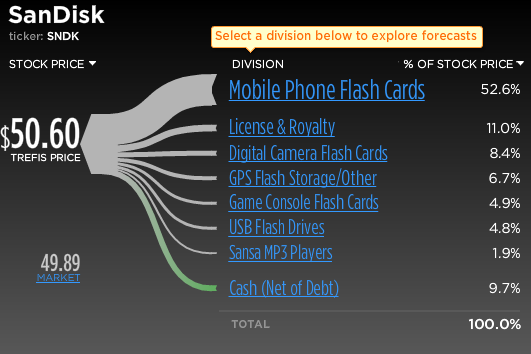SanDisk gains from boom in SSD storage
The maker of USB drives and flash memory cards will derive more of its value from them in the future.
 This
year could be big for SanDisk (SNDK
+1.46%) as technology advancements, changing dynamics in the PC industry,
new enterprise server and storage architecture, and hard disk drive (HDD)
shortages boost the worldwide solid-state-drive (SSD) storage market.
This
year could be big for SanDisk (SNDK
+1.46%) as technology advancements, changing dynamics in the PC industry,
new enterprise server and storage architecture, and hard disk drive (HDD)
shortages boost the worldwide solid-state-drive (SSD) storage market.
According to a report from the research firm IDC, solid-state-storage industry revenue reached $5 billion in 2011, a 105% increase from the $2.4 billion in 2010, and it's expected to expand further in 2012 and beyond. The report estimates worldwide SSD shipments will increase at a compound annual growth rate (CAGR) of 51.5% from 2010 to 2015. SanDisk competes primarily with Samsung and Toshiba in the SSD market.
While SanDisk derives most of its revenue from the sale of flash memory cards and USB drives, SSDs are fast becoming a major product segment. We estimate that SanDisk will derive more of its value from SSDs in the future.
Below we take a look at the major factors driving growth in SSDs:
In 2011, SSD market revenue more than doubled, driven by increasing use of flash in enterprise solutions, explosive growth of mobile client devices, and lower SSD pricing. These factors, in addition to a shortfall in HDD supply resulting from flooding in Thailand in late 2011, are expected to drive SSD shipments and revenues up in 2012.
Pricing has been a key metric as far as adoption of SSDs is concerned, in both client and enterprise markets. Because HDDs are much cheaper than SSDs, they are the preferred choice for storage as long as performance (both speed and size) is not an issue. However, with IDC expecting client SSD prices to fall below $1 per gigabyte in the second half of 2012, SSD adoption in the PC market could get a boost.
Also, the flooding in Thailand has disrupted the PC supply chain and the HDD industry's ability to supply the market. OEMs are taking a hit from HDD shortages and higher HDD prices, and they are expected to turn to SSD vendors to fill supply gaps.
The PC market is witnessing massive changes from growth in media tablets and ultrabooks (thin and fast notebooks typically equipped with SSD storage) to the increased use of caching solutions, such as dual drives (systems containing both an SSD and an HDD). With a slurry of PC manufacturers launching ultrabooks in 2012, this could be a big year for SSDs -- as well as SanDisk.
In the age of cloud, enterprises are finding HDD incapable of keeping up with the high computing speeds required by their complex applications. This is driving the adoption of solid state storage as a complementary solution to HDD storage for enterprise applications.
While most of the data archiving will still be done using HDDs for the foreseeable future because of the low price, the more frequently used data (or cache) will shift to SSDs.
We have a $50.60 Trefis price estimate
for SanDisk and will soon release our new model for SanDisk with a separate
breakout for SSDs.
By Trefis on Mon, Jan 16, 2012 2:15 PM

No comments:
Post a Comment